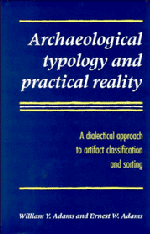 Archaeological Typology and Practical Reality
Archaeological Typology and Practical Reality Book contents
- Frontmatter
- Contents
- List of figures
- List of tables
- The archaeologist's preface
- The philosopher's preface
- PART I Introductory
- PART II The nature of types and typologies
- PART III Typology in action: the Medieval Nubian Pottery Typology
- 9 Origin and development of the Nubian Typology
- 10 Basic features of the Nubian Typology
- 11 The uses of the Nubian Typology
- 12 Philosophical implications
- PART IV Pragmatics of archaeological typology
- PART V Classification, explanation, and theory
- Appendices
- References
- Index
11 - The uses of the Nubian Typology
Published online by Cambridge University Press: 23 November 2009
- Frontmatter
- Contents
- List of figures
- List of tables
- The archaeologist's preface
- The philosopher's preface
- PART I Introductory
- PART II The nature of types and typologies
- PART III Typology in action: the Medieval Nubian Pottery Typology
- 9 Origin and development of the Nubian Typology
- 10 Basic features of the Nubian Typology
- 11 The uses of the Nubian Typology
- 12 Philosophical implications
- PART IV Pragmatics of archaeological typology
- PART V Classification, explanation, and theory
- Appendices
- References
- Index
Summary
The two previous chapters were concerned, respectively, with the classificatory and with the descriptive procedures involved in the making of the Nubian Typology. It remains here to consider the recording procedures that are involved in its use; that is, in the practical application of the typology to the study of actual ceramic material. While the classificatory and descriptive procedures are, as we saw, rather complex and detailed, we will observe here that the recording procedures are correspondingly simple.
The word “correspondingly” is used advisedly, for there is a negative relationship between descriptive and recording complexity. That is, the more detailed and specific is the information encoded in type descriptions, the less such information need be recorded for individual specimens. The mere assignment of a sherd or vessel to Ware W14 (see Appendix B) is enough to describe its method of construction, fabric, surface finish, and colors, as well as to indicate the range of possible vessel forms and decorative designs.
The material to be studied
The archaeologist typically finds pottery in two quite different forms: as sherds (fragments) and as complete vessels. The differences between these two kinds of ceramic remains are more than just a matter of completeness; they involve also the kinds of information that can be derived from the two sources. Whole pots are usually found in some place where they were intended to be, while sherds usually are not. They have come to their final resting places through successive accidents of breakage, discard, and possibly redeposition.
- Type
- Chapter
- Information
- Archaeological Typology and Practical RealityA Dialectical Approach to Artifact Classification and Sorting, pp. 128 - 142Publisher: Cambridge University PressPrint publication year: 1991
